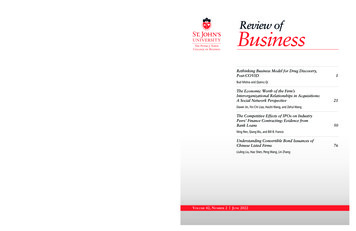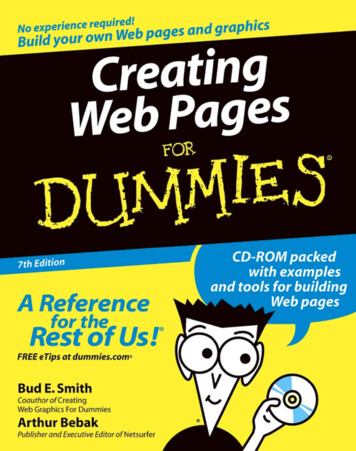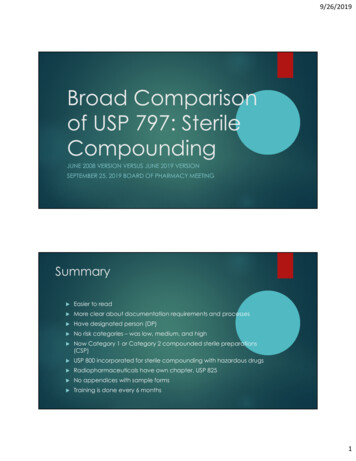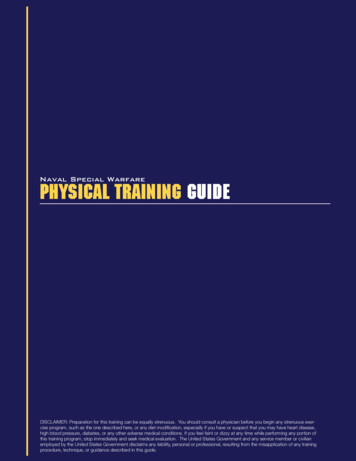
Transcription
Review ofBusinessReviewofReview ofNon-Profit Org.U.S. PostagePAIDSt. John’s UniversityNew YorkInterdisciplinary Journal on Risk and SocietyBusinessBusinessInterdisciplinary Journal on Risk and SocietyInterdisciplinary Journal on Risk and SocietyThe Peter J. Tobin College of Business8000 Utopia ParkwayQueens, NY 11439stjohns.eduRethinking Business Model for Drug Discovery,Post-COVID1Bud Mishra and Qianru QiReview of Business The Economic Worth of the Firm’sInterorganizational Relationships in Acquisitions:A Social Network Perspective21Dawei Jin, Yin-Chi Liao, Haizhi Wang, and Zehui WangVolume 42The Competitive Effects of IPOs on IndustryPeers’ Finance Contracting: Evidence fromBank Loans50 Ning Ren, Qiang Wu, and Bill B. FrancisNumber 2Understanding Convertible Bond Issuances ofChinese Listed FirmsLiuling Liu, Hao Shen, Peng Wang, Lin ZhangVolume 42, Number 2 June 202276
Review ofBusinessInterdisciplinary Journal on Risk and SocietyEditorYun ZhuSt. John’s University, United StatesAdvisory BoardIftekhar HasanFordham University, Bank of Finland, and University of Sydney, United StatesKose JohnNew York University, United StatesSteven Ongena University of Zurich, Swiss Finance Institute, KU Leuven, and Center for Economicand Policy Research (CEPR), SwitzerlandRaghavendra RauUniversity of Cambridge, United KingdomDavid ReebNational University of Singapore, SingaporeEditorial BoardTuranay CanerNorth Carolina State University, United StatesSantiago Carbó-ValverdeCUNEF, SpainSandeep DahiyaGeorgetown University, United StatesSudip DattaWayne State University, United StatesCo-Pierre GeorgUniversity of Cape Town, South AfricaXian GuDurham University, United KingdomOmrane GuedhamiUniversity of South Carolina, United StatesRoman HorváthCharles University, Czech RepublicPatrick FlanaganSt. John’s University, United StatesSuk-Joong KimUniversity of Sydney, AustraliaAnzhela KnyazevaSecurity Exchange Commission, United StatesChih-Yung LinNational Chiao Tung University, TaiwanKristina MinnickBentley University, United StatesJerry ParwadaUNSW Sydney, AustraliaMaurizio PompellaUniversity of Siena, ItalySteven W. PottierUniversity of Georgia, United StatesAlon RavivBar Ilan, IsraelVictoria ShoafSt. John’s University, United StatesAkhtar SiddiqueOffice of the Comptroller of the Currency, United StatesBenjamin TabakFGV, BrazilTuomas TakaloBank of Finland, FinlandHongfei TangSeton Hall University, United StatesAmine TaraziUniversity of Limoges, FranceKrupa ViswanathanTemple University, United StatesWolf WagnerRotterdam School of Management and CEPR, The NetherlandsNoriyoshi YanaseKeio University, JapanGaiyan ZhangUniversity of Missouri– Columbia, United StatesHao ZhangRochester Institute of Technology, United StatesReview of Business is published twice a year.ISSN: 0034-6454Review of Business is a peer-reviewed academic journal. The journal publishes original research articles in all academicfields of business, both theoretical and empirical, that will significantly contribute to the literature of business and allieddisciplines. The journal advocates for research articles in imminent topics, such as sustainable development, technologyrelated business issues, and topics that enrich the interdisciplinary understanding of business.The Peter J. Tobin College of BusinessSt. John’s UniversityNew YorkCopyright 2022, St. John’s University.www.stjohns.edu/ROB (for submissions, style guide, publishing agreement, and standards of integrity)The views presented in the articles are those of the authors and do not represent anofficial statement of policy by St. John’s University.ROBJournal@stjohns.edu (for inquiries and communications)
FromtheEditorWe are delighted to publish the June 2022 issue of Review of Business. Thisissue features four academic papers that span a diverse spectrum of business research topics, including post-pandemic business practice, the value of corporatenetworks in mergers and acquisitions (M&As), the impact of peer firms’ initialpublic offerings on competitor’s financing cost, and an inquiry into convertiblebonds in China.The lead article, “Rethinking Business Model for Drug Discovery, PostCOVID” by Mishra and Qi,1 proposes a peer-to-peer business model forCOVID-19 drug discovery. The model democratizes the drug discovery processand reduces drug prices by cutting the intermediaries that stand between biomedical researchers and future patients. With a signaling game-theoretic mechanism, this paper not only elucidates how the stakeholders strategically interact inthis market using deception, adverse selection, and moral hazards, but also howto tame their interactions to improve overall performance. Using extensive simulations, the authors show that, in the non-fungible token (NFT) megafund, bothsenior and junior tranche investors get their principals fully repaid 99.9 percentof the time. With the help of innovation in financing, this paper shows thatmarket micro-structure can help reduce health disparities in three ways. First,by participating in the drug discovery process, the underrepresented populationcan accelerate drug discovery for diseases unique to themselves. Historically,such diseases have been understudied due to a lack of funding and resources.Second, cutting out the middleman can significantly reduce drug-developmentcosts, which will increase access to medicine. Finally, retail investors can alsobenefit from investing in drug discovery because the risk associated with theNFT is managed down to the level of debt.In the second article, “The Economic Worth of the Firm’s Interorganizational Relationships in Acquisitions: A Social Network Perspective,” Jin, Liao,Wang, and Wang adopt the social network methodology in the M&A processto capture the target firms’ network position and relate it to abnormal returnsexperienced by the acquiring firms on the announcements. With a sample of728 completed acquisitions in the United States from 1990 to 2011, this paperdocuments positive stock market responses to the target’s network centrality.The combined centrality and the relative centrality of the acquiring firm andthe target firm enhance the performance of a particular acquisition. Also, thepositive effects of the target firm’s centrality on the acquirer’s shareholder valuecreation are stronger when the acquisitions are related deals, or the acquirer hasprior experience in the target’s industry. This study offers a systematic analysisof whether and how a target firm’s network position leads to the shareholdervalue creation of the acquirer and demonstrates that the externally derived network position and resources of the target firm can influence the stock market’svaluation of M&A deals.In the next article, “The Competitive Effects of IPOs on Industry Peers’Finance Contracting: Evidence from Bank Loans,” Ren, Wu, and Francis raiseThis article was edited and processed by Dr. Hongfei (Frank) Tang. And it was originally for theCOVID-19 special issue of January 2022. It is accepted in the regular issue of June 2022.1i
iiFROM THE EDITORthe question of how a successful IPO impacts the incumbent companies’ bankloan terms, as the successful IPO will affect industry peers’ bank loans via escalated product market competition and financing market competition. Using adifference-in-difference approach, the authors find that after the successful IPO,bank loans initiated for the industry’s incumbent firms have significantly higherloan spread, higher likelihood of employing performance pricing provisions, andhigher commitment fees; the syndicate loan structure for industry incumbentsbecomes more concentrated after successful IPOs in the industry; the numberof lenders declines while lead bank share increases. With solid evidence andmethodology, this paper reveals that the IPO competitive effects are more pronounced among firms in more intensive industrial competition and with higherlevels of information asymmetry. It implies that IPO competitive effects impactthe peers’ bank loan terms via product market competition and financing marketcompetition.Liu, Shen, Wang, and Zhang contribute their work “Understanding Convertible Bond Issuances of Chinese Listed Firms” as the fourth article of thisissue. This paper helps explain why Chinese firms issue convertible bonds. Thepaper is motivated by the observation that most convertible bonds issued bylisted firms in China from 2003 to 2014 were converted to equity before thematurity date, a practice distinguish from their counterparts in the United Statesand the European Union, suggesting that the convertible bond in China is usedas a backdoor equity financing instrument. Using a sample of 77 convertibledebt, 655 straight debt, and 1089 seasoned equity issues in China from 2003to 2014, the authors show that firms are more likely to issue convertible bondsrather than straight debt when the debt-related cost is low and stock price runup is high. Compared to seasoned equity issuers, firms issue convertible bondswhen the risk-free rate is low. The evidence suggests that while listed firms inChina still seek equity financing first, they issue convertible bonds to take advantage of the interest rate deduction with the assurance to their investors that theconvertibles can be converted to equities. In addition, most convertible bondswere underpriced on the offering date, suggesting convertible bond issuers donot exploit local investors in China.We sincerely hope that both scholars and professionals will find this issueof Review of Business constructive and enlightening. We will continue to publishhigh-quality scholarly articles that answer the most imminent questions in thebusiness fields.Yun Zhu, Editor
Review of Business 42, no. 2, 1–20. Copyright 2022 St. John’s University.Rethinking Business Model forDrug Discovery, Post-COVIDBud MishraQianru QiAbstractMotivation: The COVID pandemic underscores the need for fair access to healthcare. The unequal access to needed but patented, expensive medicines will exacerbate existing disparities among disadvantaged populations. For example, cancer gene therapy costs range from 373,000 for a single dose of CAR-T therapyYescarta to 2.1 million for Zolgensma.Premise: In this paper, we propose a peer-to-peer business model for drug discovery that democratizes the drug discovery process and reduces drug prices bycutting the intermediaries between biomedical researchers and future patients.Note that in this market microstructure, the underrepresented group can takeadvantage of medical advances by selling their data for research.Approach: We devise a market microstructure in which a group of project managers, who are usually “star” scientists or CEOs of biotech firms, will select individuals at disease risks and researchers, raise funds by selling non-fungible tokens (NFTs) based on their future patents, and control risks by the rating system,due diligence, and financial engineering. Employing a signaling game-theoreticmechanism, our analysis not only elucidates how the stakeholders strategicallyinteract in this market using deception, adverse selection, and moral hazards,but also how to tame their interactions to improve the overall performance. Inparticular, we suggest and rigorously evaluate an embodiment built on a scalableimplementation of NFTs.Results: Using extensive simulations, we show that in the NFT megafund, bothsenior and junior tranche investors get their principals fully repaid 99.9 percentof the time.Conclusion: This market micro-structure can help reduce health disparity in thefollowing three ways. First, by participating in the drug discovery process, theunderrepresented population can accelerate drug discovery for diseases uniqueto themselves. Historically, such diseases are understudied due to a lack of funding and resources. Second, cutting out the middleman can significantly reducedrug-development costs, which will increase access to medicine. Finally, retailinvestors can also benefit from investing in drug discovery because the risk associated with the NFT is managed down to the level of debt.Bud Mishra, PhD, New York University, mishra@nyu.eduQianru Qi, PhD, University of Ottawa, qqi@uottawa.ca1
2REVIEW OF BUSINESSConsistency: As a disruptive technology, blockchain has created a lot of challenges and uncertainties for the economy and society alike. This research provides a framework to realize the potential of blockchain and non-fungible tokensto democratize the drug discovery process and reduce health disparity, whilecontrolling their risks using rating system, due diligence, and financial engineering, which is consistent with the purpose of this journal.Keywords: blockchain, cancer megafund, economics of science, financial engineering, non-fungible token (NFT), peer to peerJEL Classification Codes: G32, I1, L65, O3INTRODUCTIONThe COVID-19 pandemic has unequally affected many racial and ethnic minority groups who face multiple barriers to accessing health care. Lack of insurance, transportation, child care, or ability to take time off work are just someof the disparities that keep them from going to the doctor. In fact, the pandemichas exposed the longstanding structural drivers of health disparities, such ashousing, physical work environment, social support, stress, nutrition, and physical activity, which interlink with class, ethnicity, gender, education level, andother factors (see Chowkwanyun and Reed 2020; Lopez, Hart, and Katz 2021for detailed studies and data). This increasing awareness of health disparity hasprompted widespread calls for fair access to health care system in a post-COVIDera (e.g., CDC’s guideline on health equality1).This paper focuses on the business model of drug discovery and how itshould be adjusted to reduce disparities in health care. The unequal access toneeded but patented, expensive medicines exacerbate existing disparities amongdisadvantaged populations (e.g., Essien, Dusetzina, and Gellad 2021) has beenwell documented. Take cancer drugs for example. The recent breakthroughsin genetic therapy beg for urgent and fundamental changes in the health carefinancing system. Genetic therapy, as constrained by its perceived small marketsizes, is expected to raise the already sky-high prices of specialty drugs, thus aggravating already frustrated patients (e.g., Stern, Alexander, and Chandra 2017;Workman et al. 2017). For example, the first 1 million per injection genetictherapy, Glybera, was withdrawn from the market because of a lack of demand(Senior 2017). The 84,000-per-treatment drug, Sovaldi, is not covered by manyinsurers until the patient develops severe liver damage (Kardish 2014). Suchhigh drug prices are tolerated without a serious debate because, according to theconventional wisdom, they are necessary for medical innovation, which is expensive, time-consuming, and risky in comparison to other technologies. However, if we look at the workforce behind every medical innovation, namely, thebiomedical scientists, their research environment has been steadily deterioratingduring the past thirty years, as the spending on prescription drugs increasedby an order of magnitude. For example, during 1980–2016, the percentage ofbiomedical PhDs who found research-related positions has dropped from 65 nity/health-equity/race-ethnicity.html
R E T H I N K I N G B U S I N E S S M O D E L F O R D R U G D I S C O V E R Y, P O S T- C O V I D355 percent,2 the average age of a biomedical scientist who received his or herfirst funding from National Institute of Health (NIH) increased from 36 to 42,and the success rate for a research proposal to get NIH funding dropped from40 percent to below 20 percent. In addition, a typical journey for a creative biotech entrepreneur in translating a discovery to commercialization remains fullof unusually large number of hurdles (investment, due-diligence, IP protection,etc.)—resulting in an experience, commonly described by the practitioners as a“Valley of Death” (e.g., Alberts 2018; Fernandez, Stein, and Lo 2012; Kahn andGinther 2017; Levitt and Levitt 2017). These findings are alarming because thedrug discovery business model, in its simplest form, is an implicit social contract between patients and researchers. The goal of such contracts is to motivateresearchers to find a cure for patients and get rewarded for their work. All theother stakeholders in the health-care industry—government, patient advocacygroups, pharmaceutical companies, and insurance companies—are supposed tomake this process more efficient and affordable, and not to make it more complicated, opaque, and ultimately, burdensome to both patients and researchers.Well aware of the flaws of current business models for drug discovery, somebiomedical research labs start to auction non-fungible tokens (NFTs) based ontheir past scientific discovery to raise funding (Jones 2021). An NFT is a unitof data stored on a blockchain that certifies a digital asset to be unique andtherefore not interchangeable. The distinct construction of each NFT has thepotential for several use cases. For example, they are an ideal vehicle to digitallyrepresent physical assets like real estate and artwork (Whitaker 2019; Whitakerand Kräussl 2020), or intellectual assets like patent and medical data. Becausethey are based on blockchains, NFTs can also be used to remove intermediaries,simplify transactions, and connect innovators with customers. Public attentiontoward NFTs has exploded in 2021, generating 23 billion dollars in trading volume in 2021, hundred times more than that in 2020.3Theoretically, NFT has the potential to democratize the drug discoveryprocess that has traditionally benefited pharmaceutical companies, which arethe intermediaries that stand between biomedical researchers and future patients. However, it does not necessarily reduce health disparity. Indeed, empirical studies aiming at characterizing properties of the NFT market show thatthe structure of the the NFT co-ownership network is highly centralized andsmall world–like. After analyzing 6.1 million trades of 4.7 million NFTs using160 separate cryptocurrencies between June 2017 and April 2021, Nadini et al(2021) found that “the top 10 percent of traders alone perform 85 percent of alltransactions and trade at least once 97 percent of all assets.”To fulfill NFT’s promise of reducing health disparity, we devise a marketmicro-structure in which a group of project managers, who are usually “star”scientists or CEOs of biotech firms, will select individuals at disease risks basedon a their medical data (e.g., a shared genomic mutation in the individuals that istargeted for therapeutic intervention) and researchers based on their skills, repu2Research-relatedjobs are defined as tenure-track positions in universities or research positions inpharmaceutical radingvolume-in-2021/?sh 57b0900f5f0a
4REVIEW OF BUSINESStation, and network. The project managers raise funds by selling NFTs based ontheir future patents (henceforth bio-coin) and control risks by a rating system,due diligence, and financial engineering. Note that, in this market micro-structure, underrepresented groups can take advantage of medical advances by sellingtheir data for research. The investment in diversified translational innovationalso improves the liquidity of the underlying fungible tokens in a Keynesianmanner. In fact, a few companies have already been experimenting with ways forcustomers to sell genomic data on blockchain marketplaces (DeFrancesco andKlevecz 2019). For example, Nebula Genomics uses blockchain technology toallow 15,000 people whose entire genomes it has sequenced to grant temporaryaccess to their data to specific users (such as biotech startups searching for linksbetween genes and diseases). This market micro-structure can help reduce healthdisparity in the following three ways. First, by participating in the drug discovery process, underrepresented population can accelerate drug discovery for thediseases that are unique to themselves—historically such diseases are understudied due to lack of funding and resources. Second, cutting out the middleman cansignificantly reduce the drug-development costs, which in turn will increase theaccess to medicine. Third, retail investors can also benefit from investing in drugdiscovery because the risk associated with the NFT is managed down to the levelof debt, as our simulation shows in “Return to the Investors.”This paper has been partially motivated by research from Andrew Lo andhis collaborators on a cancer megafund (e.g., Chaudhuri et al. 2018; Das et al.2018; Fagnan et al. 2013; Fagan et al. 2015; Fojo and Lo 2016; Siah et al. 2019;Wong et al. 2018). However, it is worth noting parenthetically that the organizational structure of this decentralized megafund is fundamentally different fromthat of the megafund proposed by Fagnan et al. (2013) (henceforth, centralizedmegafund). In the centralized megafund, the fund managers need to optimizedecisions of capital structure, through the buying and selling of compounds foreach experiment, as well as the hiring and contracting of researchers in eachstage of the drug development. The possibility of a misalignment of interestsbetween fund managers and investors—one of the primary reasons behind the2007–2009 financial crisis—could significantly reduce the profitability of sucha megafund (Yang, Debonneuil, and Zhavoronkov 2016). The megafund wouldovercome this concern by using a decentralized, transparent, and market-basedsolution for drug development. All the activities are direct contracts betweeninvestors (potential patients) and researchers using the blockchain and smartcontract technology. By avoiding a central authority governing the market andother transitional institutions, it avoids non-transparency and deception associated with market manipulation. It also globalizes the system and encouragesscaling with liquidity.The paper also builds on the earlier work of Yang, Debonneuil, andZhavoronkov (2016) on a cancer megafund with embedded “lemon” projectsin the information asymmetric structure. This paper improves on that work byfurther reducing information asymmetry, deceptive behavior, and thus overallrisks that may derive from the megafund itself. Specifically, for the bio-coin to beacceptable to all investors, scientists, and future patients (individuals at diseaserisks), we need to ensure that all participants in the drug development agree onthe value of this NFT. The drug-development process is highly experimental in
R E T H I N K I N G B U S I N E S S M O D E L F O R D R U G D I S C O V E R Y, P O S T- C O V I D5the sense that its success rate depends on the talents, stamina, and perseveranceof scientists, and its outcome cannot be evaluated solely by computer modelsin silico. Therefore, some additional institutions to facilitate the drug discoveryprocess and honor the commitment by the bio-coin are also needed. For example, a reputable rating agency will significantly reduce the informational asymmetry between future patients (individuals at disease risks) and the scientists. Inthe rating agency, each proposal of a scientific project requires deploying a datascience algorithm (machine learning, systems biology, disease modeling, etc.) toverify that it has a solid theoretical and experimental foundation. In addition,the cost of due diligence has diminished exponentially because of the significantbreakthroughs in systems biology, synthetic biology, high throughput lab-onchip, and omics technology have been making.A real-life example of such a rating agency is the Operation Warp Speedcommittee for U.S. COVID vaccine development. This committee funded 8 projects out of 250 vaccine candidates, and 6 of these 8 vaccine candidates have beenapproved by FDA as of today, which shows that it is possible to significantly increase the success rates of investment by conducting careful due diligence. Otherexamples are online analysts for initial coin offerings (ICOs). According toLee, Li, and Shin (2021), analysts can predict the success rates of an ICO withhigh accuracy.The paper is organized as follows. “Institutional Background” first explores why the cooperation in biotechnology research is rapidly breaking down.Next, “New Approaches” elaborates on how the bio-coin megafund can helpsolve this problem. “Description of the Equilibrium” presents the nature of financial returns to future patients (individuals at disease risks), scientists, andinvestors in our new incentive systems, as well as empirical analysis via simulation. The conclusion follows with a succinct discussion on the benefit of ourapproach.INSTITUTIONAL BACKGROUNDThis divergence between health-care spending and innovation is attributed to thecentral institutional feature in the current health-care market: the demand side ofmedical innovation does not match the supply side directly (Ellis and McGuire1993). The demand of medical innovation comes from the fundamental needof each individual to insure against the significant health and monetary lossescaused by illness (Lakdawalla, Malani, and Reif 2017; Philipson and Zanjani2014). All these needs are then pooled, in the form of taxation and insurancepremiums, respectively, by the government and insurance companies and redistributed, in the form of research funds and payment to prescription drugs, tothe supply side of medical innovation–research institutions, biotech, and pharmaceutical companies. The drawback of such a centralized system, like mostother centralized systems, is that it blocks the accurate information flow in thefeedback loop for each individual to impact the price and quality of health-careproducts, thus opening doors for “price-gouging” by pharmaceutical companies and inefficiency in capital allocation as described above. As our knowledgeabout the linkage between genome and diseases keeps on evolving, the potentialconflict of interests between the centralized authority and the general public mayeventually harm the patients’ welfare. For example, although testing a patient’s
6REVIEW OF BUSINESSwhole genome sequence for predictive biomarkers is crucial for personalizedtreatments, it may negatively affect a person’s insurance coverage and life insurance premium; therefore, (potential) patients are reluctant to make the bestuse of these tests. A transparent and decentralized health-care financing system,where the drug prices are set at market equilibrium and capital is allocated tomeet the real-time demand, is a necessary complement to our current health-carefinancing system.Figure 1 compares the current health-care financing models with the peerto-peer model. In the current health system, there are four stages for each biotechnological research: (1) Funding; (2) Innovation and research; (3) Clinicaltrials and regulatory approval; (4) Pricing and marketing. Based on these stages,we categorize all the current research processes into two major approaches: Not-for-profit approach: Government agencies (or charity and other publicorganizations) collect funds from taxpayers (or the general public), andthen distribute funds to scientists in the university labs or research institutions based on the peer-review process. When scientists make a breakthrough, they either start up an enterprise through a technology transferoffice or they license it to pharmaceutical companies. Market approach: Pharmaceutical companies collect funds from venturecapitalists or the capital market and hire scientists to work on promisingprojects. If a drug is approved by FDA, companies price it and sell it in themarket or to hospitals.In both of these approaches, participants from each stage usually have conflicts of interest, leading to fragmented strategies and agendas, which stifle information sharing across research teams necessary to advance treatments and cures.Specifically, the not-for-profit approach suffers from the following threeproblems. First, government or non-profit organizations end up inefficiently allocating resources. For example, politicians may steer taxpayer’s money awayfrom drug development to serve their interests. As a result, under-investmentis always an issue for not-for-profit drug development. Second, the interests ofscientists and patients are not fully aligned. Purely academic competition amongFIGURE 1. Stages of Traditional Biotechnology ResearchThe current business models struggle with various forms of adverse selection, deception, and moral hazards, which result from informationasymmetry, exacerbated by misaligned utilities, lack of a community wide social norms, and enforceable complete l TrialsPricing andMarketingGovernmentand CharityUniversity niesVenture Capital,Stock uticalCompaniesPharmaceuticalCompaniesCure orTreatments
R E T H I N K I N G B U S I N E S S M O D E L F O R D R U G D I S C O V E R Y, P O S T- C O V I D7scientists, while beneficial in basic science research, prohibits them from sharingresearch results transparently and only a small percentage of NIH-funded medical research yields positive results that end up in publications. Third, the drugprice is determined by pharmaceutical companies, therefore there is no controlby the taxpayer or patients (who through charity invest their money in the firstplace) to interact with the other key players rationally but strategically.Although the market approach is more efficient in allocating resources,pharmaceutical companies may take advantage of its inherent information asymmetry to maximize corporate profit by charging high drug prices for the patients.In addition, they may only focus on disease groups that pro
2 days ago










